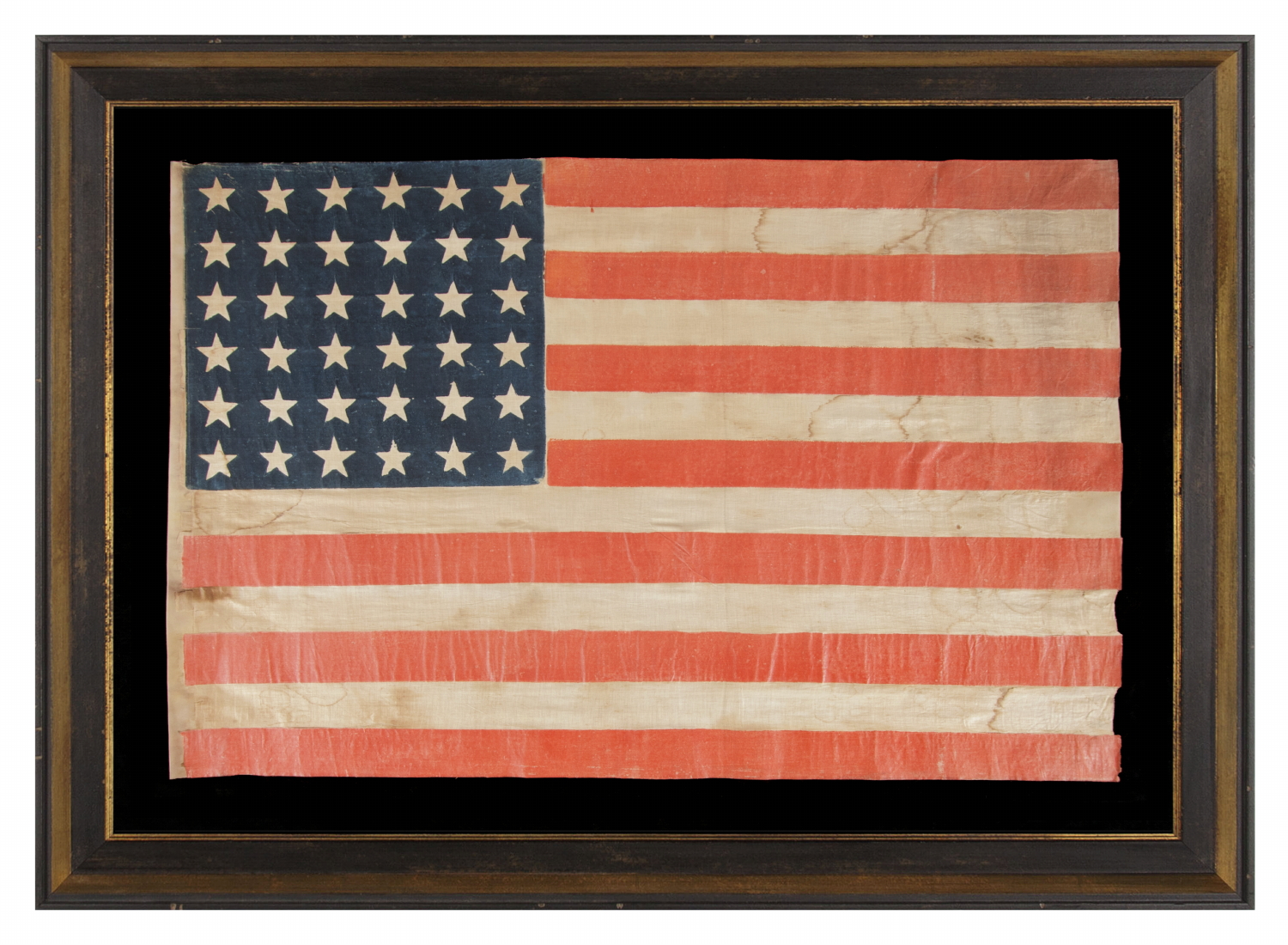
| |
36 STAR ANTIQUE AMERICAN PARADE FLAG OF THE CIVIL WAR ERA, IN AN ESPECIALLY LARGE SCALE AND WITH BOLD COLOR, 1864-67, NEVADA STATEHOOD |
|
| Available: |
Sold |
| Frame Size (H x L): |
Approx. 40" x 55" |
| Flag Size (H x L): |
28.25" x 43.25" |
|
| Description....: |
|
36 star American national flag of the Civil War era, printed on coarse, glazed cotton. The 36th state, Nevada, entered the Union during the Civil War on October 31st, 1864. The last Confederate general surrendered on May 26th, 1865. The 36 star flag became official on July 4th of that year, but makers of printed flags would have begun adding a 36th star to their flags in 1864, even before the addition of the new state occurred.
Lincoln pushed Nevada through to statehood on October 31st, 1864, during the Civil War, and just 8 days before the November election. The territory’s wealth in silver was attractive to a nation struggling with the debts of war and so increased support for the Republican ticket. While the 36th star wasn't officially added until July 4th of the following year, the makers of printed flags are known to have begun adding the 36th star as early as July of 1864, several months before the addition of Nevada actually occurred. This was a common practice during the late 19th century and is reflective of both the nation's desire for Westward Expansion and the hope of flag-makers to bring new star counts to market before their competitors. The 36 star flag was officially replaced by the 37 star flag in 1867, following the addition of Nebraska.
Parade flags generally measured three feet or less on the fly. At 42.5" this is a particularly large example. Before 1890 flags with pieced-and-sewn construction were typically 8 feet long and larger. Even infantry battle flags were 6 x 6.5 feet. Because printed parade flags were rarely as large as this one and sewn flags were rarely this small, and because the size is relatively ideal--manageable but large enough to make a bold statement-- this is an especially desirable example.
In addition to its size, note the vibrant, chrome orange color of the stripes. Many cotton parade flags produced between 1850 and 1876 have shades of red that lean strongly toward orange. This was typical of the period and the presentation of these flags can be striking.
Mounting: The flag has been hand-stitched to 100% cotton twill, black in color, which was washed to reduce excess dye. An acid-free agent was added to the wash to further set the dye and the fabric was heat-treated for the same purpose. The mount was placed in a black-painted, hand-gilded and distressed Italian molding. The glazing is U.V. protective Plexiglas.
Condition: There are minor to moderate losses in the white area along the hoist where the flag was affixed to its original wooden staff and in the white stripes at the fly end. Fabric of similar coloration was placed behind these areas for masking purposes. There is minor to moderate water staining and oxidation throughout. The strength of the colors is are excellent, however, across known examples of this variety. Most in this style have significant fading and dye loss. Many of my clients prefer early flags to show their age and history of use. |
|
|
|
| Collector Level: |
Intermediate-Level Collectors and Special Gifts |
|
| Flag Type: |
Parade flag |
|
| Star Count: |
36 |
|
| Earliest Date of Origin: |
1864 |
|
| Latest Date of Origin: |
1867 |
|
| State/Affiliation: |
Nevada |
|
| War Association: |
1861-1865 Civil War |
|
| Price: |
SOLD |
|
| |
Views: 3773 |
|
|
|

